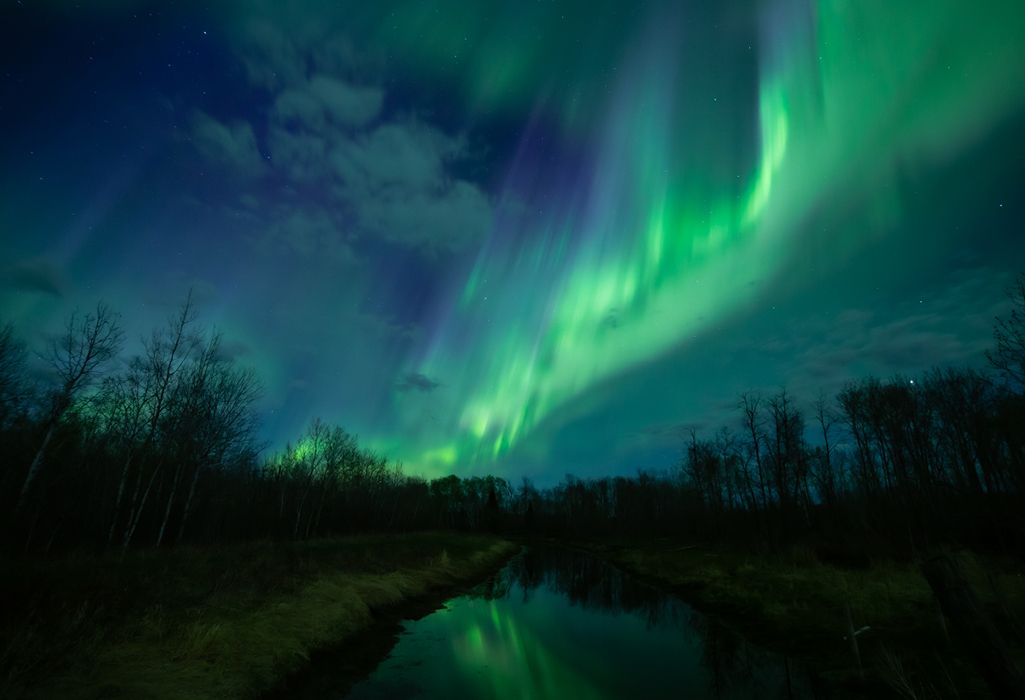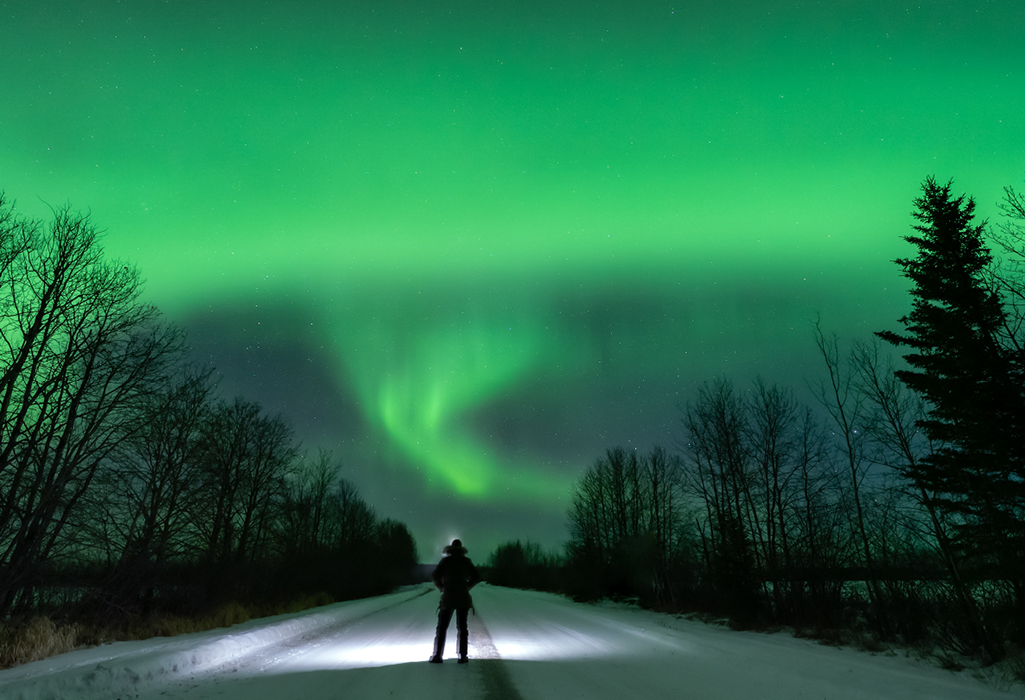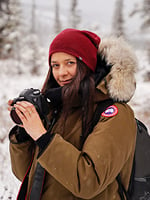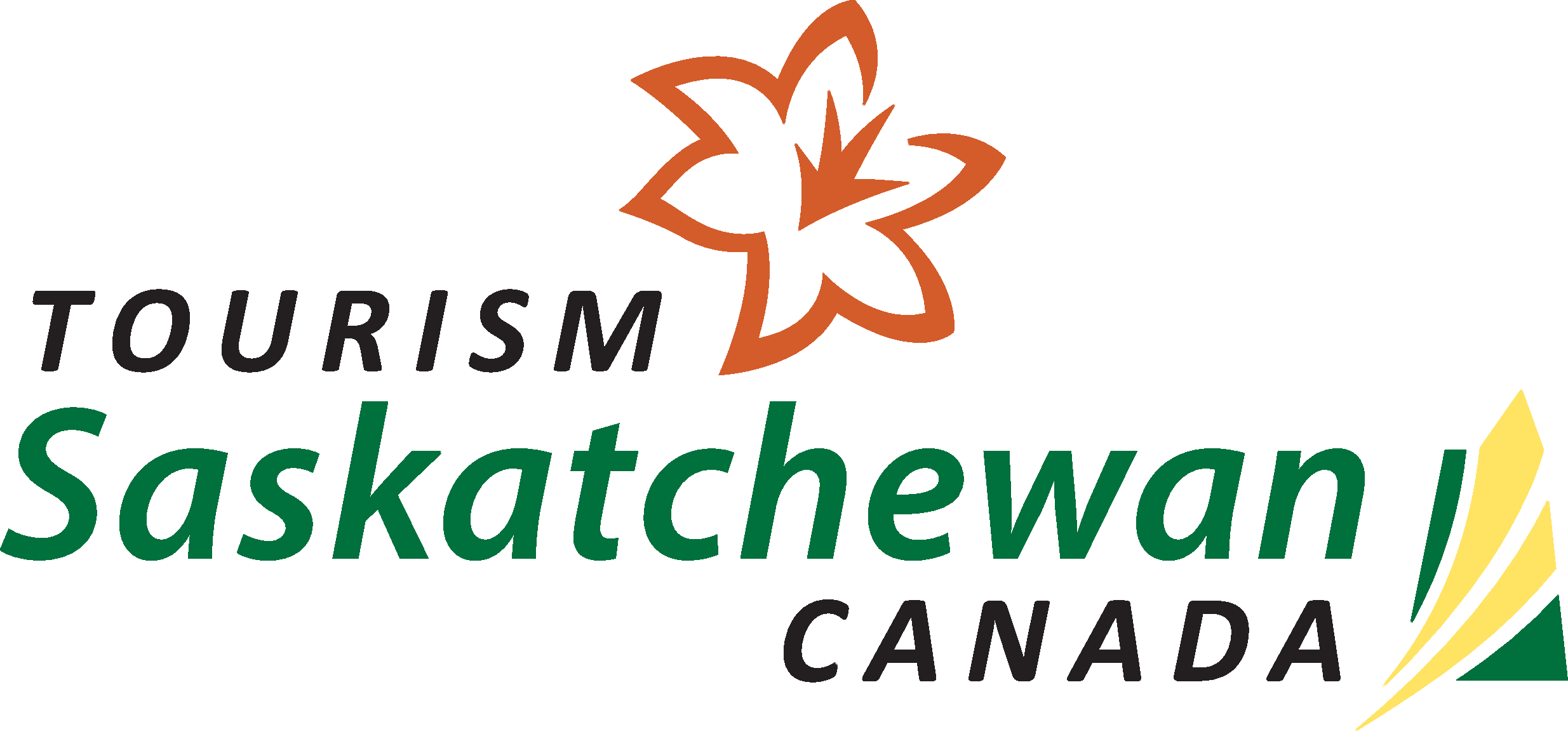How to See the Northern Lights in Saskatchewan
*NOTE: While chasing the aurora, remember to stay safe and respectful. Stick to public areas, avoid trespassing, and be mindful of others enjoying the lights. Keep any little ones close—rural roads can be dangerous in the dark. Plan ahead, drive carefully, and let’s make the magic of the Northern Lights a safe and shared experience for everyone.*
Saskatchewan is a great location for experiencing one of the most amazing natural wonders on earth, the northern lights. Watching the lights dance across the prairie sky is a moment remembered forever.
What are the Northern Lights and When to See Them in Saskatchewan?
The northern lights are caused by the atmosphere’s reaction to energy released by the sun. This energy creates a colourful display at night, which are the northern lights, also known as the aurora borealis.
The northern lights are very unpredictable. The most reliable forecast is produced about 30-45 minutes ahead of time by the DSCOVR satellite located over 900,000 km from earth.
Here are some helpful apps that show this information in a user-friendly format:
- Aurora Alerts is a great app for incorporating aurora predictions with current weather in an easy-to-read format. SpaceWeatherLive is a bit more in-depth and a reliable source.
- Checking the data for updates is essential, as a forecast can change drastically. For live updates, the Saskatchewan Aurora Hunters Facebook group is a great source of information.
Without diving deep into the science of it all, here are some important things to consider in an aurora forecast:
- KP Index is an estimate of activity in the forecast. It is a generalization of strength but is not always reliable. A KP of 5 or higher is considered storm level and can mean a good show is highly predicted, but again, it is not a guarantee. There have also been great shows at low KP levels.
- BZ is one of the most important indicators for the data and it needs to be negative to pull the northern lights into view. A high negative BZ number for a sustained period of time can help produce a good show visible across Saskatchewan.
When to See Them
The best times of year to see the northern lights are February through April or September through October.
These are the best months based on aurora activity, hours of darkness and weather. Aurora can occur any night of the year. Winter has more hours of darkness, meaning higher chances of seeing them. During the summer, the long daylight hours mean fewer hours to see the northern lights and is not considered an ideal time.
Times of Day
The northern lights can only be seen during the dark, about two hours after sunset until two hours before sunrise. At midnight, the aurora oval is at its peak over Saskatchewan. However, this is a general guideline as some shows start as soon as it gets dark and some start much later. Some shows last a very short time, while others last all night. Again, it is highly unpredictable and changes each night.

Where to see the Northern Lights in Saskatchewan and Picking a Location
The great part is since the northern lights occur in the sky, they can be visible almost anywhere in Saskatchewan depending on the strength of the show. Most often, overhead views and the best views occur in the north. In the south, it’s more typical to see the northern lights lower on the horizon. A strong aurora storm of KP5+ can be seen overhead anywhere in Saskatchewan.
Picking a Location
- Avoid light pollution by driving about 20 minutes out of the city to either the north, west or east. You don’t want to have light pollution between you and the northern horizon, so heading south of a city isn’t recommended. The further from the city the better, making small towns and rural areas ideal places to get an easily accessible view.
- To help you find a dark location near you, check the dark sky finder map.
- Stay away from major roads and highways and make sure to pull off safely when you find a quiet gravel road or public parking area.
- Be respectful of private property and nearby homes; make sure not to unintentionally alarm someone by parking near their house at night.
- Having an unobstructed view of the northern horizon is important. A field, lake or valley facing north works well.
- Know the area. It is best to check out your location during the day to look for hazards, safe parking and road conditions.

What to Consider when Planning to View the Northern Lights and Improving your Experience
- Cloud Cover: Heavy cloud cover or fog will block your view. For ideal conditions, a clear sky is best. There are apps that predict cloud cover that you can download right to your phone.
- Moon Phase: It is best to go when there is no moon, or as little as possible to allow for the darkest sky. There are nights when the northern lights can outshine even a full moon; however, that happens less frequently.
- What to Expect: A northern lights show will often start as a faded white haze in the sky. The white hazy band can transform quickly into bright vibrant moving colours. Digital cameras pick up the green in this white haze and often mislead people to think they are always vibrant green. Once this haze intensifies, our eyes can see the bright vibrant colours, but this isn’t every time. The show is always different.
- Avoid using lights, or having headlights on when there are others viewing with you. Any source of light will obstruct the view for yourself and others.
- It takes about 15 minutes for our eyes to adjust to darkness. This means it’s best not to look at any source of light as your eyes need to readjust every time.
- Bring a head lamp or flashlight and extra batteries for safety.
- Dress Warm: Even in warm weather, it gets cold at night when standing or sitting still watching the sky. In the winter, bring heat packs and extra layers.
- Safety gear is important when heading out at night. Let someone know where you will be and having a booster pack for your vehicle is a good idea for backup. Batteries die faster in the cold, so ensure cellphones and gear are fully charged. Satellite communicators are great for areas out of cell range.
- Patience is important. The northern lights are highly unpredictable, and a great show can come out of nowhere.
- Don’t forget your favourite warm drinks, snacks and a blanket to cuddle up with loved ones for the show.
With a little patience, determination and preparation, you can be enjoying a bucket list moment right here in Saskatchewan, watching the enchanting northern lights dance into the night!
Author and Photographer: Jeanine Holowatuik
 Jeanine Holowatuik is an astrophotographer and avid aurora chaser with a passion for dark skies, capturing nature and exploring the wilderness. Based in the boreal forest around Hudson Bay, she is a full-time Community Development Director by day and aurora photographer by night.
Jeanine Holowatuik is an astrophotographer and avid aurora chaser with a passion for dark skies, capturing nature and exploring the wilderness. Based in the boreal forest around Hudson Bay, she is a full-time Community Development Director by day and aurora photographer by night.
Follow her on Instagram to see more of her work.

